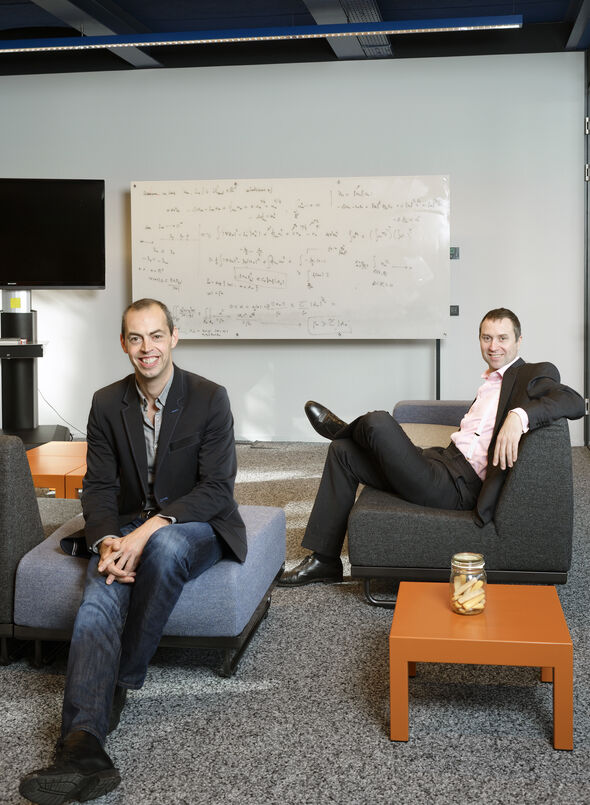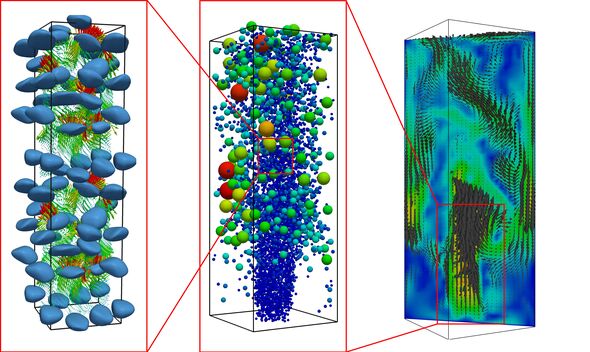- Research
- 17/10/2012
Connecting sciences
Next week, the Eindhoven Multiscale Institute (EMI) will be celebrating its official opening with a three-day scientific symposium and an SG lecture by prof.dr. Alfio Quarteroni. Professors Harald van Brummelen and Mark Peletier, director and vice-director of EMI respectively, talk about the hows and whys of this ‘virtual’ TU/e institute.
“I like to say three-quarters of TU/e researchers is involved in multiscale research”, says Peletier. “That may be an overstatement, but it sure is a lot.” Van Brummelen: “During the startup of the institute, we contacted thirty professors whose focus is on multiscale research, and a dozen more to whom it’s of secondary interest.”
At the departments of Mathematics, Mathematics & Computer Science, Applied Physics, Chemical Engineering and Biomedical Engineering, multiscale is a major theme. “But there are researchers at Built Environment and Electrical Engineering who are looking for a broader forum for the topic. Multiscale is one of the strong suits of TU/e.”
The institute wants to bridge the gap between departments. Its members will have regular meetings in the Advanced Study Center in Ceres, the brand new home of ICMS, organize workshops and colloquiums, and submit joint research proposals in the future. On top of that, EMI is supposed to serve a promotional purpose as well. Peletier: “We’re hoping authoritative lecturers will be more willing to come to Eindhoven at an invitation of the Multiscale Institute than they would be at one of the departments.”
“We’ve already noticed people tend to find each other faster”, says van Brummelen. “Because of the institute, there’s now a coherent set of electives on the subject for the Bachelor College, which wouldn’t have been feasible without EMI.”
In Van Brummelen’s office, Peletier (professor at the CASA center of Mathematics & Computer Science, and co-founder of ICMS) and the former (head of the Multiscale Engineering Fluid Mechanics section of the Department of Mechanical Engineering, and connected to CASA as well) explain what ‘multiscale’ means.
Peletier has a great example from biology. “In the human body, the various length scales exist very naturally. Proteins and other molecules form cells, and combined, those cells form tissue. Organs are made of a number of tissues. The organs make up the organism, which functions within an ecological system of all kinds of other organisms.”
Eventually, ecosystems are made up of the same molecules that are present in cells. Still, based on the molecular makeup of a cell it is already hard to say one or two things about its functioning, so just imagine skipping a number of length scales and do the same about an entire ecosystem or society.
Van Brummelen: “Particle physicists like to brag about how they’re the only ones involved in actual fundamental science, saying everything follows from their findings. But let’s be fair, the behavior of elementary particles can hardly predict anything about the human psyche. Connecting phenomena from different scales is a science in its own right, and that’s multiscale.”

The director of the new institute phrases it slightly differently: “Traditionally, scientists divide the systems they describe into ever smaller components, until they’re left with something so small they can actually wrap their heads around it. At some point, however, you’ll lose touch with the big picture. Multiscale goes back to larger length scales; how do these tiny components work together to achieve certain behavior in a larger scale?”
An important concept in this respect is emergence: systems with a large number of relatively simple components turn out to display surprisingly complex behavior. The origin of life, for example, may be considered an emergent phenomenon.
Multiscale research is gaining an ever more prominent position in today’s science, and in large part that can be credited to the computing power of modern computers, says Peletier. “It allows us to calculate systems with more and more particles, be they proteins, cells, or individuals. These particles often prove to engage in interesting stuff together. As a scientist, you can be working on your computer and suddenly find something you would have never expected. Things like that make you want to find answers.”
“Another reason multiscale is becoming increasingly popular, is we’re starting to realize there are many things we can’t calculate”, says Van Brummelen. “Years ago, we were so excited about the idea we could calculate at all, we didn’t stop to think there could be limits to our possibilities.”
Peletier agrees: “I can vividly remember what French professor Olivier Pironneau said twenty years ago: today, we can calculate the airflow around a car driving five kilometers an hour. To calculate the airflow at six kilometers an hour, we need a thousand times more computing power. That takes years, because you need more and more data points really quickly, since the faster the car moves, the smaller the air vortices become. Multiscale techniques are indispensable if you want to say anything about friction at realistic speeds.”
“What we’re saying is: we’ll never be able to calculate the flow profile at those realistic speeds exactly”, Van Brummelen adds. “In one of my own lines of research, we’re currently working on finding the friction force – the number that should be deduced from the flow profile, ideally – without having to calculate the entire profile.”
“A similar process occurs with dilute gases, which are gases containing so little particles their molecular structure becomes important”, he says. “This is important for ASML’s chip machines, for example. You want to know about the thermal conductivity in those machines. That’s easy enough for higher pressures, where the gas can be considered a continuum, but dilute gases are hard to model entirely, so you’ll have to look for ways to determine the heat transfer only.”
Peletier shares an example taken from his own multiscale research as well: “We work with Tata Steel (formerly known as Hoogovens, ed.) to create a new generation of very strong, lightweight steel. The main problem lies in the grain structure of the metal – the areas with a certain crystal-like structure. The pliancy of the steel depends on the structure of the grains, but the way the grains move in relation to each other is also important, right up to the level of a sheet of steel for a car. It really is a multiscale problem.”
When will EMI be considered successful, according to the founders? “For me, it’s when it starts generating new science, when it sprouts new ideas”, says Van Brummelen. “You could also say the annual €50,000 overhead is worth it if you can do a joint project that brings in the external funding for a single doctoral candidate. But I prefer the new-science criterion.”

Discussion